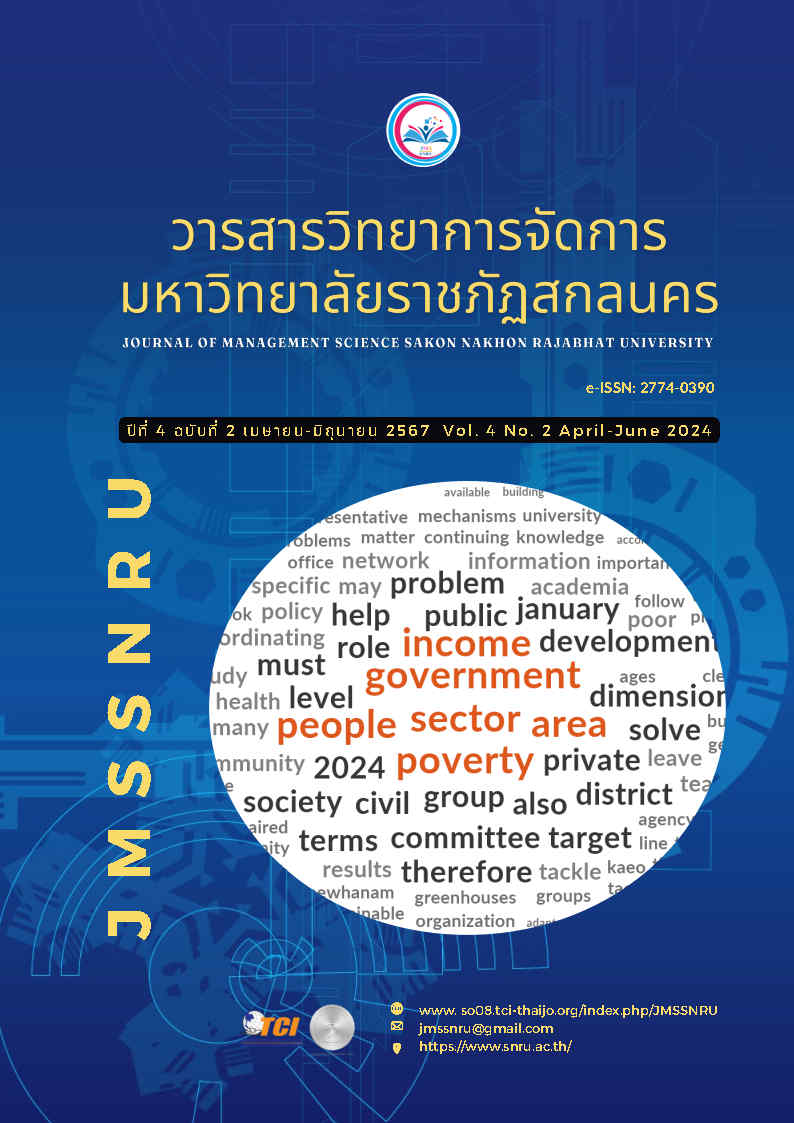SERVICE QUALITY AND IMAGE AFFECTING CUSTOMER’S SATISFACTION OF HOTEL IN MUANG DISTRICT, UTTARADIT PROVINCE
Keywords:
service quality;, image;, satisfaction;, hotelAbstract
The objectives of this research were 1) to study the important level of service quality, image and customer satisfaction; and 2) to study the service quality and customer satisfaction on hotel image Muang District, Uttaradit Province. The population is people was previously stayed at hotels. Sample random sampling was employed, 385 people. Was used for date collection namely frequency, percentage, mean, standard deviation and multiple regression analysis. The research findings showed that service quality was prioritize at a highest level, with responsiveness being the highest, followed by empathy. In addition, Image was prioritize at a highest level, with institution image being the highest, followed by service image. Moreover, the results of the research hypothesis testing revealed that services quality influenced customer satisfaction, with a statistical significance level of .01. The explanation of the variation in empathy was tangible and assured. As for reliability and responsiveness the statistical significance level of .05 The explanation of the variation in services quality that affects the customer was satisfaction was 67.50 percent (R2 = .675). In terms of image, it was found that institution image, service image and brand image had a statistically significant influence at a significance level of .01. The image that variation effected on customer satisfaction was 71.50 percent (R2 = .715).
References
กระทรวงการท่องเที่ยวและกีฬา. (2565). สถิติด้านการท่องเที่ยว ปี 2564. สืบค้น 10 พฤศจิกายน 2565. จาก https://www.mots.go.th/news/category/630.
บุญเลิศ จิตตั้งวัฒนา. (2558). การพัฒนาการท่องเที่ยวแบบยั่งยืน. (พิมพ์ครั้งที่ 2). (ฉบับปรับปรุง). กรุงเทพฯ: ธรรมสาร
ศูนย์วิจัยธนาคารออมสิน. (2563). ธุรกิจโรงแรม. กรุงเทพฯ: หน่วยวิเคราะห์เศรษฐกิจภาคบริการ ส่วนเศรษฐกิจราย สาขา. สำนักงานการท่องเที่ยวและกีฬาจังหวัดอุตรดิตถ์. (2565). แผนพัฒนากลุ่มจังหวัดภาคเหนือตอนล่าง 1 พ.ศ. 2561-2565 ฉบับทบทวน ปี 2564. พิษณุโลก: สำนักงานการท่องเที่ยวและกีฬาจังหวัดพิษณุโลก.
Abd-El-Salam, E. M., Shawky, A. Y. & El-Nahas, T. (2013). The impact of corporate image and reputation on service quality, customer satisfaction and customer loyalty: Testing the mediating role. Case analysis in an international service company. The business and management review, 3(2), 177-196.
Cheney, G. and S. L. Vibbert. (1987). Corporate Discourse: Public relations and issue management. Newbury Park, CA: Sage.
Cochran, W.G. (1963). Sampling Techiques. New York, John Wiley & Sons. Inc
Cretu A. E., & Brodie R. J., (2007). The influence of brand image and company reputation where manufacturers market to small firms: A customer value perspective. Industrial Marketing Management. 36(2), 230–240.
Dutton, J. E. and J. M. Dukerich. (1991). Keeping an eye on the mirror Image and identity in organizational adaptation. Academy of Management Journal 34(3), 517-554.
Dutton, J. E., J. M. Dukerich and Harquail, C.V. (1994). Organizational images and member identification. Administrative Science Quarterly 39, 239-263.
Felix, R. (2017). Service quality and customer satisfaction in selected banks in Rwanda. Journal of Business & Financial Affairs, 6(1), 246-256.
Gerpott, T. J., Wolfgang Rams., & Andreas Schindler. (2001). Customer retention, loyalty and satisfaction in the German mobile cellular telecommunications market. Telecommunications Policy, 249-269.
Goeltom, V. A. H., kristiana, Y., Juliana, J., Bernato, I. & Pramono, R. (2020). The Effect of Service Quality and Value of Five-Star Hotel Services on Behavioral Intentions with the Role of Consumer Satisfaction as Mediator. The Journal of Asian Finance, Economics, and Business, 7(11), 967-976.
Grace, S. L. (2003). The role of hotel image and image congruence and their effects on repeat intention in the hotel industry. Michigan: ProQuest information and learning company, 49-62
James, T. L., Calderon, E. D. V., & Cook, D. F. (2017). Exploring patient perceptions of healthcare service quality through analysis of unstructured feedback. Expert Systems with Applications, 71, 479-492.
Kandampully, J., & Suhartanto, D. (2000). Customer loyalty in the hotel industry: the rule of customer satisfaction and image. International Journal of Contemporary Hospitality Management, 12(6), 346-351.
Ki-Joon, B. (2001). The effects of image congruence on customer satisfaction and brand loyalty in the lodging industry. Michigan: ProQuest information and learning, 113.
Kotler, P., Armstrong, G., Saunders. J. & Wong, V. (1999). Principles of Marketing (2nd ed.). New Jersey: Prentice-Hall.
Kotler, P. (2000). Marketing management. (10th ed.). Upper sanddle river, NJ: Prentice hall, Inc.
Lai, W. T. & Chen, C. F. (2011). Behavioral intentions of public transit passengers – The roles of service quality, perceived value, satisfaction and involvement. Transport Policy, 18, 318-325.
Lewin, J. E. (2009). Business customers' satisfaction, What happens when suppliers downsize.
Li, X. & Petrick, J. F. (2010). Towards an integrative model of loyalty formation. The role of quality and value. Leisure Sciences, 32(3), 201-221.
Moffitt, M. A. (1994). Collapsing and integrating concepts of public and image into a new theory. Public Relations Review, 20(2), 159-170.
Noe, F.P., Uysal, M., & Magnini, V.P. (2010). Tourist Customer Service Satisfaction: An Encounter Approach. New York, Routledge.
Nunnally, J. C. and Bernstein, I.H. (1994). The Assessment of Reliability. Psychometric Theory, 3, 248-292.
Parasuraman, A., Zeithaml, V. A., & Berry, L. L. (1990). Delivering Quality Service: Balancing Customer Perceptions and Expectations. New York: The free press.
Tefera, O. & Govender, K. (2017). Service Quality, Customer Satisfaction and Loyalty: The Perceptions of Ethiopian Hotel Guests. Journal of Hospitality, Tourism and Leisure, 6(2), 1-22.
UNTWO. (2021). UNWTO WORLD TOURISM BAROMETER. สืบค้น 10 พฤศจิกายน 2565 จาก https://www.unwto.org/unwto-world-tourism-barometer-data.
Zeithaml, V. A., Berry, L. L. & Parasuraman, A. (1988). SERVQUAL: A multi-item scale for measuring consumer perception of service quality. Journal of Retailing, 64(1), 12-40.
Zeithaml, V. A., Bitner, M. J. & Gremler D. D. (2009). Services marketing: Integrating customer focus across the firm. (5th ed). New York: McGraw Hill.
Downloads
Published
How to Cite
Issue
Section
License
Copyright (c) 2024 JOURNAL OF MANAGEMENT SCIENCE SAKON NAKHON RAJABHAT UNIVERSITY

This work is licensed under a Creative Commons Attribution-NonCommercial 4.0 International License.
An article published in the Journal of Management Science. Sakon Nakhon Rajabhat University is the opinion, copyright and responsibility of the author of the work.







